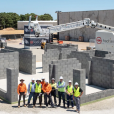Clinical stage pharmaceutical company, Pharmaxis (ASX: PXS) has spent the quarter waiting and watching.
As clinical trials on their lead asset progress, and others begin to take shape, the Company has been focussed on strengthening their position as a global leader in fibrotic conditions.
CEO Gary Phillips attended the BIO conference in San Diego, USA where he shook hands with 13,000 members of the international biotech community.
Despite the sad state of biotech stocks on the NASDAQ with a serious loss in value over the past few months, Pharmaxis remains confident that their underlying technology and upcoming clinical trial results will be able to weather the stock market storm.
“While there was much uncertainty about the future at BIO, I reflected after the meeting that Pharmaxis is fortunate to have a pipeline that is well advanced into the clinic,” said CEO, Gary Phillips. “We will have much to report on between now and the end of 2022.”
Trials progressing for lead asset PXS-5505
Pharmaxis’ lead asset PXS-5505 is currently in a Phase 2 trial as a monotherapy treatment for rare blood cancer myelofibrosis.
Laying down of scar tissue within the bone marrow is a characteristic of myelofibrosis that Pharmaxis is aiming to treat. This scar tissue affects the marrow’s ability to produce blood and immune cells leading to multiple complications. PXS-5505 has shown promise as a disease modifying treatment that meaningfully addresses the underlying cause of scar tissue build up, helping to ease symptoms and decrease disease burden on patients.
The current treatment market for this disease is estimated at USD $1 billion per annum with only one class of drug currently in use. These drugs, called JAK inhibitors do little to stem the disease progression, only alleviating symptoms. And, they don’t work for every patient.
Those participating in the trial have been deemed as ineligible for JAK inhibitor therapy and consequently, have advanced myelofibrosis.
So far, the study has recruited 11 out of 24 subjects. Despite recruitment being slower than the Company would have hoped, US sites have recently opened and the company anticipates it will reach full recruitment during Q4.
The Company is expecting to have a large body of data from this open label study to review by year end.
PXS-5505 is a potential silver bullet for multiple other cancers
PXS-5505’s pre-clinical data speaks for itself, and has sparked the interest of multiple researchers around the globe. This interest has seen PXS-5505 become the subject of another Phase 1c clinical trial, led by the University of Rochester Medical Centre and the Wilmot Cancer Institute.
The investigator-initiated trial will seek to evaluate the efficacy of the drug in patients with liver cancer following promising preclinical results.
Planning is well underway with the trial design already receiving approval from the United States FDA and Investigational New Drug status awarded to the drug for the new indication.
Researchers believe that PXS-5505 can serve as a vital adjunct to traditional chemotherapy to tackle solid cancers like those in the liver. Only 20-30% of liver cancers are able to be removed through surgery, with most patients having to undergo chemotherapy to fight the cancer. With the incidence of primary liver malignancies having doubled in the last twenty years, and the chemotherapy market worth over USD $50 billion per annum, the drug could fill a very wide gap.
Researchers at the Garvan Institute in Sydney, Australia are also interested in the drug, but for pancreatic cancer. With survival post diagnosis just a measly 6-8 months (even with our best therapeutics), pancreatic cancer is one of those that we just haven’t been able to get a grasp on. Dr Tom Cox from the Garvan spoke at Pharmaxis’ R&D Showcase event where he highlighted the challenges facing pancreatic cancer researchers, and affirmed the Institute’s interest in the drug’s mechanism of action.
PXS-5505 has also attracted attention from researchers looking into myelodysplastic syndrome, melanoma and glioblastoma. The Company is only too happy to support independent research on their drugs which builds on the body of promising data they’re already creating.
Same platform, different application- PXS-6302 for skin scarring
Using the same fibrosis eliminating technology, Pharmaxis is also developing a topical anti-fibrotic drug to treat skin scars.
The well publicised trials (thanks to Channel Nine) are currently being run at the University of Western Australia and the Fiona Stanley Hospital, led by Professor Fiona Wood AO, a renowned researcher in the field of skin and burns.
Initial safety trials involving 8 patients gave the PXS-6302 a green light, with recruitment now underway for a further 42 patients with established skin scars to participate.
The study will span three months and data will be reported before the end of 2022.
A second trial looking at the drug’s efficacy in burns is in the works too, with recruitment expected to begin in the second hand of the year.
Bronchitol business in the background
With clinical trials and research very much in the foreground for Pharmaxis, we can’t neglect to comment on their mannitol respiratory business.
Pharmaxis’ approved proprietary drug Bronchitol (mannitol) is designed for the treatment of cystic fibrosis. The Company also created Aridol, a lung function test that is used by clinicians across multiple jurisdictions for the monitoring and diagnosis of asthma.
These two products are approved for sale and distribution across Australia, Europe, Russia, the United States, and several other countries.
Like all markets, Pharmaxis’ respiratory business has felt the impact of COVID. With CF patients being highly vulnerable to respiratory diseases such as COVID, the pandemic has seen an adjustment to patient management. US and European distributor of the drug, Chiesi, has reported that many CF patients are now attending management appointments twice a year instead of four times which was the norm prior to COVID.
Additionally, other cystic fibrosis drugs have entered the market in recent years however, Pharmaxis is monitoring the situation and notes that none of these “directly assist with mucus clearance which remains an ongoing need for patients.”
As such, the Company has reduced their forecast EBITDA, but is still expecting the division to be EBITDA positive for FY23 and beyond.
The Company has rounded out the quarter with $8.9 million in the bank. A further $4.9 million R&D tax credit is also expected to be received in the December quarter.
- Parkinson’s UK backs Pharmaxis with $5 million to slow the onset of incurable disease with ‘ground breaking’ trial - September 1, 2022
- How this company is developing medtech to support Indigenous community health - August 22, 2022
- A round of ap-paws for PharmAust, changing the ruff prognosis for dogs with lymphoma - August 17, 2022












Leave a Comment
You must be logged in to post a comment.